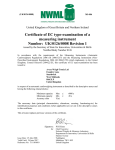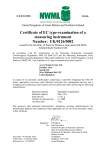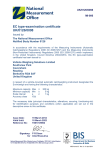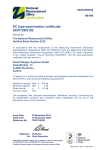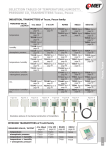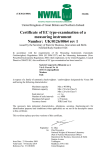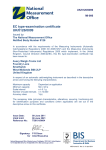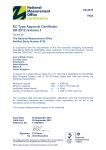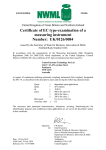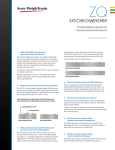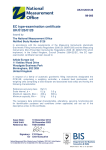Download EC type-examination certificate UK/0126/0011 Revision 2
Transcript
UK/0126/0011 MI-006 EC type-examination certificate UK/0126/0011 Revision 2 issued by: The National Measurement Office Notified Body Number 0126 In accordance with the requirements of the Measuring Instruments (Automatic Catchweighers) Regulations 2006 (SI 2006/1257) and the Measuring Instruments (Non-Prescribed Instruments) Regulations 2006 which implement, in the United Kingdom, Council Directive 2004/22/EC, this EC type-examination certificate has been issued to: Avery Weigh-Tronix Foundry Lane Smethwick West Midlands B66 2LP United Kingdom in respect of an automatic catchweighing instrument as described in the descriptive annex and having the following characteristics: Maximum capacity Max Minimum capacity Min Accuracy class Y(a) ≤ ≥ 6000 e 20 e The necessary data (principal characteristics, alterations, securing, functioning etc) for identification purposes and conditions (when applicable) are set out in the descriptive annex to this certificate. This revision replaces previous versions of the certificate. Issue Date: Valid Until: Reference No: 06 June 2011 04 September 2017 T1110/0006 Signatory: P R Dixon for Chief Executive National Measurement Office | Stanton Avenue | Teddington | TW11 0JZ | United Kingdom Tel +44 (0)20 8943 7272 | Fax +44 (0)20 8943 7270 | Web www.bis.gov.uk/nmo 0135 MID Annex B Rev. 2 01 April 2011 Descriptive Annex 1 INTRODUCTION This pattern of an automatic catchweighing instrument operates as an automatic weight labeller (Category Y). It comprises three conveyors (in-feed, weigh and out-feed), an AWTX 1310 weight indicator and a label printer. The 1310 indicator is connected to a PC which provides an electronic data storage facility. A second “down-steam” label printer is also provided. The instrument is designed to weigh packs statically. Pack and labelling information is stored in data files, selectable for the commodity and/or labels being processed. Labels are printed with the required transaction data and are applied to the packs automatically. 2 FUNCTIONAL DESCRIPTION 2.1 Mechanical 2.1.1 The instrument comprises a supporting framework which supports the motorised weigh conveyor which comprises a conveyor mounted on to a weigh platform which incorporates the load cell(s). 2.1.2 The weighing module is connected to an AWTX model 1310 weight indicator (Figure 1) which is connected to a PC. A label printer and barcode scanner are mounted above the weighing conveyor. Photocells are used to detect the pack and control the operation of the system. A second label printer, located downstream from the instrument, applies a “duplicate” label to the outer box. 2.2 Electrical 2.2.1 The electrical hardware is located within the 1310 indicator, label printers, PC and a control panel. The control panel contains the motor controls and associated power supplies. 2.2.2 The control of the instrument is provided by the PC, via I/O modules. The preset tare associated with the product is entered via the 1310 indicator and stored. The PC requests weight data, including preset tare values, from the 1310 indicator. 2.2.3 The 1310 weight indicator contains all of the electronics associated with the weighing process and is as described in EC Test certificate GB-1153. The PC runs the Avery Weigh-Tronix “Weight for Windows” software package as described in EC Test Certificate GB-1010. This provides an electronic data storage facility, with a unique consecutive number being generated and printed onto the label. The PC provides a secondary indication of the weight and various status signals, and is used to select the product being weighed. 2.3 Load cell Any compatible load cell(s) may be used providing the following conditions are met: − There is a respective OIML Certificate of Conformity (R60) or a Test Certificate (EN45501) issued for the load cell by a Notified Body responsible for type examination under Directive 2009/23/EEC. 2/8 − The certificate contains the load cell types and the necessary load cell data required for the manufacturer's declaration of compatibility of modules (WELMEC 2, Issue 5, 2009, section 11), and any particular installation requirements. A load cell marked NH is allowed only if humidity testing to EN45501 has been conducted on this load cell. − The compatibility of load cells and indicator is established by the manufacturer by means of the compatibility of modules form, contained in the above WELMEC 2 document. − The load transmission conforms to one of the examples detailed in WELMEC 2.4 Guide for Load Cells. 2.4 Printer 2.4.1 The printer is an Advanced Labelling Systems model ALX924/5. 2.5 Devices 2.5.1 The instrument is provided with the following devices: − − − − − − − − − − 2.6 Semi-automatic zero-setting device (not operable during automatic operation) Automatic zero-setting device (before every pack) Zero-tracking device Zero indicator Tare weighing or balancing device (not operable during automatic operation) Preset tare device Net indicator Gross (B/G) indicator Real time clock Device to determine when stability criteria are fulfilled Operation 2.6.1 Packs are delivered to the weighing conveyor by the in-feed conveyor. Once detected by the associated photocell the weighing conveyor is stopped by the 1310 indicator. The 1310 indicator determines if a stable weight is obtained and the label is then applied. The barcode scanner reads the barcode on the label. If the data from the scanner is read correctly, and agrees with the data stored, then the pack continues across the out-feed conveyor. A second label printer, located downstream from the instrument, produces a “duplicate” label which is applied to the outer box. A counter is used to synchronise the packs to ensure that the “duplicate” label is applied to the correct pack. 2.6.2 If an error is detected by the barcode scanner, or if the pack is outside predefined weight limits, an error signal is generated and the instrument is stopped. The pack must then be removed from the system and the error acknowledged. 3/8 3 TECHNICAL DATA 3.1 The instrument has the following technical characteristics: Power supply Maximum number of scale intervals Load cell excitation voltage Minimum load cell impedance Maximum load cell impedance Minimum input voltage per verification scale interval Measuring range minimum voltage Measuring range maximum voltage Fraction of maximum permissible error Climatic environment Electromagnetic environment Accuracy class Load cell cable 3.2 220-240 Vac 50/60 Hz 6000 10 Vdc 28 Ω 1100 Ω 2 µV 12 mV 50 mV Pind = 0.5 0 °C to 40 °C Non-condensing (closed) E1 and E2 Y(a) 6 core with braided outer screen. 0.5 mm2 per core, flexible PVC overall jacket Maximum length = 5 m (10 m/mm2). Documentation and drawings Document / Drawing No. FDS 103669 V1.4 103669 UM V2.1 50692 50693 51571 51572 53021 50799 50800 51631 51632 3.3 Description Functional design specification User manual Main PCB assembly Main PCB circuit diagram Multi-channel analogue output PCB assembly Multi-channel analogue output board circuit diagram Network interface PCB assembly Serial I/O and PSU PCB assembly Serial I/O and PSU circuit diagram Display and keyboard interface PCB assembly Display and keyboard interface PCB circuit diagram Software 3.3.1 The weighing software is contained within the 1310 indicator and the version number is 52957-0137. The application software is V1.1. The software version numbers are accessed by: − − − − Hold in the escape key until the indicator beeps. For the User Menu, enter the password: 111 and press the enter key. From the User menu, press the soft-key marked “VIEW”. From the View menu, press the soft-key marked “VERS”. 4/8 3.3.2 The control software is contained within the PC and the version number is V 2.x, where “x” covers minor software variants. The software version number is accessed by pressing “help” & “about” when the application is running. 3.3.3 Each label printed and applied to the packs is provided with a unique consecutive number which is generated by the “Weight for Windows” data storage device running on the PC. 4 PERIPHERAL DEVICES AND INTERFACES 4.1 Interfaces The instrument may have the following interfaces: − − − 4.2 Load cell connection (hardwired) 3 x RS232/RS422 1 x powered RS422 (20 mA) Peripheral devices The instrument may be connected to any peripheral device that has been issued with a test certificate or parts certificate by a Notified Body responsible for Annex B (MI-006) under Directive 2004/22/EC in any Member State and bears the CE marking of conformity to the relevant directives; or A peripheral device without a test certificate may be connected under the following conditions: 5 − it bears the CE marking for conformity to the EMC Directive; − it is not capable of transmitting any data or instruction into the weighing instrument, other than to release a printout, checking for correct data transmission or validation; − it prints weighing results and other data as received from the weighing instrument without any modification or further processing; and − it complies with the applicable requirements of Paragraph 8.1 of Annex I. APPROVAL CONDITIONS The certificate is issued subject to the following conditions: 5.1 Legends and inscriptions 5.1.1 The instrument bears the following legends: ‘CE’ marking Supplementary metrology marking Notified body identification number Accuracy class Serial number Manufacturers mark or name Certificate number Operating temperature range 5/8 5.2 indicator. If the instrument is not permanently installed it shall be provided with a level 6 LOCATION OF SEALS AND VERIFICATION MARKS The “CE” marking, supplementary metrology marking and certificate number 6.1 are located on the mounting plate bracket which is fixed to the main structure of the conveyor stand. The CE mark shall be impossible to remove without damaging it. The data plate (Figure 3) shall be impossible to remove without it being destroyed. The markings and inscriptions shall fulfil the requirements of Paragraph 9 of Annex I of the Directive 2004/22/EC. 6.2 Access to the configuration and calibration facility for the 1310 weighing module(s) is via a push button located on the power supply PCB and is accessed through a hole in the rear of the indicators enclosure. The plastic screw, which prevents access to the push button, can be secured to the back of the enclosure by a wire and seal. Components that may not be dismantled or adjusted by the user (including the load cell junction box if applicable) must be secured by either a wire and seal or a tamper evident label and securing mark. The securing mark may be either: − − a mark of the manufacturer and/or manufacturer’s representative, or an official mark of a verification officer. 7 ALTERNATIVES 7.1 Having the system modified as follows: − − − The second label printer described in 2.6.1 is removed The version number for the control software described in 3.3.2 is V 1.x, where “x” covers minor software variants The documentation listed in section 3.2 is modified as follows: 104924 FDS V1.x Functional design specification 104924 UM V1.x User manual where “x” covers minor, non-legally relevant documentation variants 7.2 Having the documentation listed in section 3.2 modified as follows: 104907 FDS V2.x Functional design specification 104415 UM V3.x User manual where 'x' covers minor, non-legally relevant documentation variants 8 ILLUSTRATIONS Figure 1 Figure 2 1310 indicator Descriptive label 6/8 9 CERTIFICATE HISTORY ISSUE NO. DATE DESCRIPTION UK/0126/0011 05 September 2007 Type examination certificate first issued. UK/0126/0011 Rev 1 21 March 2011 Authorised alternative 7.1 added. UK/0126/0011 Rev 2 06 June 2011 Authorised alternative 7.1 modified to allow version V1.x for the documentation. Authorised alternative 7.2 added. 7/8 Figure 1 Figure 2 1310 indicator Descriptive label © Crown Copyright 2011 NATIONAL MEASUREMENT OFFICE Department for Business, Innovation & Skills 8/8








